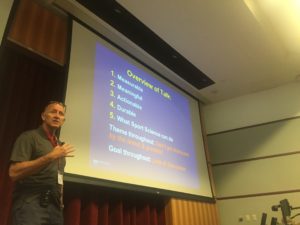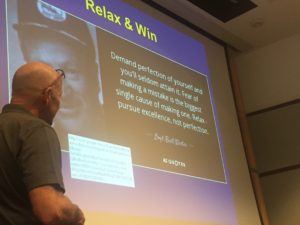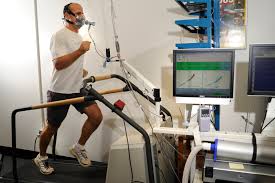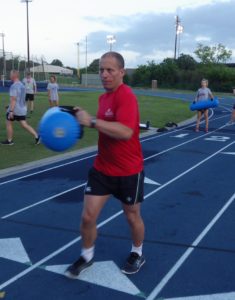Main Menu
Latest Blog Entry
User login
Dr Mike Joyner “Sport Science: Servant or Master?”
“Don’t get distracted by the latest and greatest”
Said Dr Mike Joyner at the head of his 2nd seminar at GAIN. His talk covered four key questions we need to ask before implementing a new scientific find in our training, as well as interesting insights that he has found useful.
In a discussion the evening before, Dr Joyner had revealed that “40% of medical evidence turns over every 15 years, but certain fundamentals don’t turn over”. That means that every 15 years 40% of what was “evidence” changes!
The fundamentals that are constant are: Don’t smoke; access to clean water; don’t get fat and be physically active amongst others.
As coaches it is easy to get distracted by new things and ignore the fundamentals. Similarly we may feel obliged to chuck out what is working because something new is found and published, even if that is later to be found false. (Naseem Taleb talks about this in Antifragile, he calls it neoism).
4 questions we should ask of sports science
Dr Joyner is an expert on athletic performance and is based at the Mayo clinic. His talk was extremely useful and was an example of critical thinking. (This is supposedly taught at Universities, but yet many recent graduates blindly regurgitate “facts” based on “research” without appearing to question it). Dr Joyner went through the following questions we should ask and gave examples of each.
- Is it measureable?
Max Oxygen uptake is measurable. However in a laboratory setting research needs to show a 1-5% improvement for the study to be valid. If you win a 10km race by 1% you win by 100m! Coaches are often looking for the 0.1 -1% Science can explain the big picture, but it sometimes misses the detail and often the context.
During the Vietnam war, the USA decided to try and measure winning by counting body bags of US troops versus the Viet Cong. This became known as “McNamara’s fallacy” where this became the focus of politicians rather than a meaningful political-military strategy (Assuming that anyone can actually “win” a war).
- Is it meaningful?
There is a good correlation between a runner’s Lactate Threshold (LT) and their Marathon speed. Therefore LT is both measurable and meaningful for Marathon runners. (I have seen this extrapolated to Judoka who have been told to “improve their LT” by running on a treadmill more. Here the sports scientists were getting the tail to wag the dog).
- Is it actionable?
Referring to Bud Winter’s book “Relax and Win”, Dr Joyner said that relaxation is a trainable effect. Therefore we can use it in our sessions.
“If you just turn your training sessions into exercises and suffering, you’re missing the point.”
In swimming, every turn counts, so it is important to work on each move in a meaningful way. If this (and the dive) are ignored or paid lip service to, then the performance will suffer.
- Is it durable?
Dr Joyner showed a list of diets and the research that shows if they affect weight loss. Guess what? The Atkins diet, the Zone diet, weight watchers and the Ornish diet ALL work. They work IF they are followed. The problem is that the really restrictive diets that stop people living normally like eating as a family or choosing from a restaurant menu are simply unsustainable.
Any training programme or new piece of research must be durable and last beyond 6 weeks (the length of many studies) in order for it to be effective in the long term. Think accumulation of training rather than blitzing.
What sports science can do for us
So after quite a critical look at some urban legends and poor examples, Dr Joyner then gave some examples of what we can learn mainly for endurance type activities (where his interests lie). Lactate Threshold in untrained subjects is about 60% of their maximum effort. In trained subjects it ranges from 75-90% of their max.
LT is highly trainable. The increase in mitochondria means more pyruvate is oxidised and less is shunted to lactate. “Almost anything you do that has frequency, intensity and duration” will make a difference to your Vo2 max and LT. For example:
- 3-5 minute repeats will help VO2 Max (see yesterday’s blog on The Volume Trap)
- 200m repeats will help improve LT.
Running economy in the other hand is highly variable (up to 30%) and it is unclear how trainable it is. (I always question the research on this: it is often done on treadmills and the “interventions” bear no resemblance to exercises that I do with runners to improve their technique. Conclusions are then drawn that it doesn’t work, rather than “we don’t know how to coach in a lab”.)
Dr Joyner then looked at the recent attempt to run a sub 2 hours Marathon by Nike. What did they do to try and get this time? They looked at all the small factors added together. The course, the temperature, fuelling the runners, as well as manipulating the running economy with drafting, pacing and of course the shoes.
What was interesting here was the effect of drafting (something cyclists in a peloton know) with 8% of the total energy cost of a 5km race coming from having to overcome wind resistance. In the 100m sprint this rises to 16%!
Training in a fasted state
Sports science can help us identify potential limits to human performance too. Much research has been conducted on training in a fasted stated. However, Dr Joyner made the point that so many gels are used nowadays that people rarely train in a truly fasted state.
People can fatigue from having low glycogen in the muscles or from Neuroglycopenia (Neuro= Brain, Glyco= Sugar, Penia =deficiency. So, low brain sugar). People who fast and go low on Carbohydrate (CHO) down regulate their enzymes. When they return to a normal diet, their enzymes are less able to process this food.
The impression I got from this was that that maybe we should just try to eat normally. Especially when sprinting and doing high intensity exercise: you need CHO.
The Scientific Process
I haven’t really given Dr Joyner justice due to my poor notetaking and poor grasp of physiology. However, please take away the thoughts on questioning research and what you are measuring.
I asked him at the end about “Science” which now seems to be only valid if published, versus the “scientific process” which we should all be doing as coaches wanting to improve our athletes’ performance.
He mentioned the “Citizen science” project which is about sharing ideas that work and testing them. I suggested we have an aide memoire or checklist to help us validate what we do or discard practices that are defunct.
His final words were “A lot of sports scientists are just data acquisition people and analysers”. We were in agreement that it is what we do with this information with real people that counts.
Further reading:
- Dr Joyner: 7 Sports Science Myths
- Next up: Bill Knowles on reconditioning athletes.
Client Testimonials
 Blundells School
Blundells School
James has a huge breath and depth of knowledge on fitness issues. He is able to implement this knowledge into a practical course both making the task of fitness and conditioning both different and interesting from other fitness training that most are familiar with. He understands the safety issues when dealing with young adults strength and conditioning programmes. Programmes he sets are tailored to the individual needs of the group. There was a huge amount of progress made with some of these individuals in terms of their understanding of fitness and their own fitness levels.
More






